Unit-1
Introduction and Database Modelling using ER Model
Q1) Give a brief introduction of database and its evolution
A1) Data is a collection of a distinct small unit of information. It can be used in a variety of forms like text, numbers, media, bytes, etc. it can be stored in pieces of paper or electronic memory, etc.
Word 'Data' is originated from the word 'datum' that means 'single piece of information.' It is plural of the word datum.
In computing, Data is information that can be translated into a form for efficient movement and processing. Data is interchangeable.
What is Database?
A database is an organized collection of data, so that it can be easily accessed and managed.
You can organize data into tables, rows, columns, and index it to make it easier to find relevant information.
Database handlers create a database in such a way that only one set of software program provides access of data to all the users.
The main purpose of the database is to operate a large amount of information by storing, retrieving, and managing data.
There are many dynamic websites on the World Wide Web nowadays which are handled through databases. For example, a model that checks the availability of rooms in a hotel. It is an example of a dynamic website that uses a database.
There are many databases available like MySQL, Sybase, Oracle, MongoDB, Informix, PostgreSQL, SQL Server, etc.
Modern databases are managed by the database management system (DBMS).
SQL or Structured Query Language is used to operate on the data stored in a database. SQL depends on relational algebra and tuple relational calculus.
A cylindrical structure is used to display the image of a database.

Fig 1- Image of a database
Evolution of Databases
The database has completed more than 50 years of journey of its evolution from flat-file system to relational and objects relational systems. It has gone through several generations.
The Evolution
File-Based
1968 was the year when File-Based database were introduced. In file-based databases, data was maintained in a flat file. Though files have many advantages, there are several limitations.
One of the major advantages is that the file system has various access methods, e.g., sequential, indexed, and random.
It requires extensive programming in a third-generation language such as COBOL, BASIC.
Hierarchical Data Model
1968-1980 was the era of the Hierarchical Database. Prominent hierarchical database model was IBM's first DBMS. It was called IMS (Information Management System).
In this model, files are related in a parent/child manner.
Below diagram represents Hierarchical Data Model. Small circle represents objects.
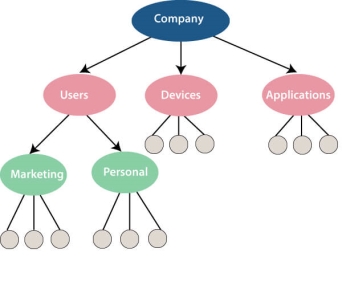
Fig 2 - Hierarchical Data Model
Like file system, this model also had some limitations like complex implementation, lack structural independence, can't easily handle a many-many relationship, etc.
Network data model
Charles Bachman developed the first DBMS at Honeywell called Integrated Data Store (IDS). It was developed in the early 1960s, but it was standardized in 1971 by the CODASYL group (Conference on Data Systems Languages).
In this model, files are related as owners and members, like to the common network model.
Network data model identified the following components:
This model also had some limitations like system complexity and difficult to design and maintain.
Q2) Give a short description of Cloud database and its advantages
A2) Cloud database
Cloud database facilitates you to store, manage, and retrieve their structured, unstructured data via a cloud platform. This data is accessible over the Internet. Cloud databases are also called a database as service (DBaaS) because they are offered as a managed service.
Some best cloud options are:
Advantages of cloud database
Lower costs
Generally, company provider does not have to invest in databases. It can maintain and support one or more data centers.
Automated
Cloud databases are enriched with a variety of automated processes such as recovery, failover, and auto-scaling.
Increased accessibility
You can access your cloud-based database from any location, anytime. All you need is just an internet connection.
Q3) What is DBMS architecture and what are its different types?
A3) The DBMS design depends upon its architecture. The basic client/server architecture is used to deal with a large number of PCs, web servers, database servers and other components that are connected with networks.
The client/server architecture consists of many PCs and a workstation which are connected via the network.
DBMS architecture depends upon how users are connected to the database to get their request done.
Types of DBMS Architecture
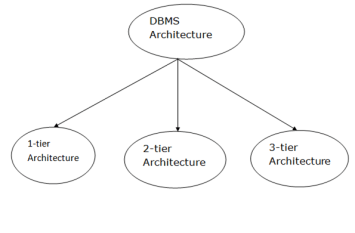
Fig 4 - DBMS Architecture
Database architecture can be seen as a single tier or multi-tier. But logically, database architecture is of two types like: 2-tier architecture and 3-tier architecture.
1-Tier Architecture
2-Tier Architecture
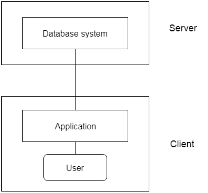
Fig 5: 2-tier Architecture
3-Tier Architecture
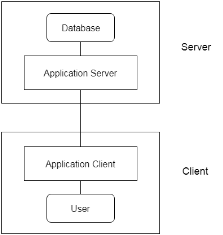
Fig 6: 3-tier Architecture
Q4) Explain in short what is a data base user?
A4) Database Users
Database users are the one who really use and take the benefits of database. There will be different types of users depending on their need and way of accessing the database.
Q5) What is database administrator and what are its types?
A5) Database Administrators
The life cycle of database starts from designing, implementing to administration of it. A database for any kind of requirement needs to be designed perfectly so that it should work without any issues. Once all the design is complete, it needs to be installed. Once this step is complete, users start using the database. The database grows as the data grows in the database. When the database becomes huge, its performance comes down. Also accessing the data from the database becomes challenge. There will be unused memory in database, making the memory inevitably huge. These administration and maintenance of database is taken care by database Administrator – DBA.
A DBA has many responsibilities. A good performing database is in the hands of DBA.
In order to perform his entire task, he should have very good command over DBMS.
Types of DBA
There are different kinds of DBA depending on the responsibility that he owns.
Q6) What is data model, ER model and relational model?
A6) Data models define how the logical structure of a database is modeled. Data Models are fundamental entities to introduce abstraction in a DBMS. Data models define how data is connected to each other and how they are processed and stored inside the system.
The very first data model could be flat data-models, where all the data used are to be kept in the same plane. Earlier data models were not so scientific, hence they were prone to introduce lots of duplication and update anomalies.
Entity-Relationship Model
Entity-Relationship (ER) Model is based on the notion of real-world entities and relationships among them. While formulating real-world scenario into the database model, the ER Model creates entity set, relationship set, general attributes and constraints.
ER Model is best used for the conceptual design of a database.
ER Model is based on −
These concepts are explained below.

Fig 7 – ER Model
Mapping cardinalities −
Relational Model
The most popular data model in DBMS is the Relational Model. It is more scientific a model than others. This model is based on first-order predicate logic and defines a table as an n-ary relation.

Fig 8 – Relational model
The main highlights of this model are −
Q7) What is DBMS and what are its characteristics?
A7) Database management system is software that is used to manage the database.
What is Database?
The database is a collection of inter-related data which is used to retrieve, insert and delete the data efficiently. It is also used to organize the data in the form of a table, schema, views, and reports, etc.
For example: The college Database organizes the data about the admin, staff, students and faculty etc.
Using the database, you can easily retrieve, insert, and delete the information.
Database Management System
DBMS allows users the following tasks:
Characteristics of DBMS
Q8) What are the advantages and disadvantages of DBMS?
A8) Advantages of DBMS
Disadvantages of DBMS
Q9) What are database languages and what are its types?
A9)
Types of Database Language

Fig 9 – DBMS Language
1. Data Definition Language
Here are some tasks that come under DDL:
These commands are used to update the database schema that's why they come under Data definition language.
2. Data Manipulation Language
DML stands for Data Manipulation Language. It is used for accessing and manipulating data in a database. It handles user requests.
Here are some tasks that come under DML:
3. Data Control Language
(But in Oracle database, the execution of data control language does not have the feature of rolling back.)
Here are some tasks that come under DCL:
There are the following operations which have the authorization of Revoke:
CONNECT, INSERT, USAGE, EXECUTE, DELETE, UPDATE and SELECT.
4. Transaction Control Language
TCL is used to run the changes made by the DML statement. TCL can be grouped into a logical transaction.
Here are some tasks that come under TCL:
Q10) Explain in brief ER model
A10)
For example,Suppose we design a school database. In this database, the student will be an entity with attributes like address, name, id, age, etc. The address can be another entity with attributes like city, street name, pin code, etc and there will be a relationship between them.
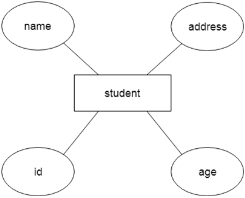
Fig 12 - Example
Component of ER Diagram
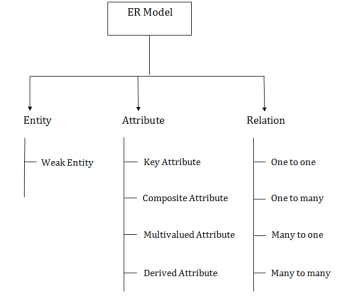
Fig 13 – Components of ER Diagram
1. Entity:
An entity may be any object, class, person or place. In the ER diagram, an entity can be represented as rectangles.
Consider an organization as an example- manager, product, employee, department etc. can be taken as an entity.

a. Weak Entity
An entity that depends on another entity called a weak entity. The weak entity doesn't contain any key attribute of its own. The weak entity is represented by a double rectangle.

2. Attribute
The attribute is used to describe the property of an entity. Eclipse is used to represent an attribute.
For example, id, age, contact number, name, etc. can be attributes of a student.
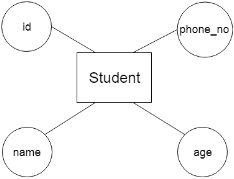
a. Key Attribute
The key attribute is used to represent the main characteristics of an entity. It represents a primary key. The key attribute is represented by an ellipse with the text underlined.
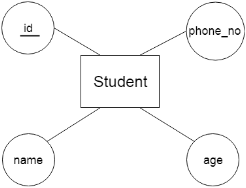
b. Composite Attribute
An attribute that composed of many other attributes is known as a composite attribute. The composite attribute is represented by an ellipse, and those ellipses are connected with an ellipse.

c. Multivalued Attribute
An attribute can have more than one value. These attributes are known as a multivalued attribute. The double oval is used to represent multivalued attribute.
For example, a student can have more than one phone number.

d. Derived Attribute
An attribute that can be derived from other attribute is known as a derived attribute. It can be represented by a dashed ellipse.
For example,A person's age changes over time and can be derived from another attribute like Date of birth.
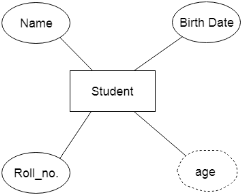
3. Relationship
A relationship is used to describe the relation between entities. Diamond or rhombus is used to represent the relationship.

Types of relationship are as follows:
a. One-to-One Relationship
When only one instance of an entity is associated with the relationship, then it is known as one to one relationship.
For example,A female can marry to one male, and a male can marry to one female.

b. One-to-many relationship
When only one instance of the entity on the left, and more than one instance of an entity on the right associates with the relationship then this is known as a one-to-many relationship.
For example, Scientist can invent many inventions, but the invention is done by the only specific scientist.

c. Many-to-one relationship
When more than one instance of the entity on the left, and only one instance of an entity on the right associates with the relationship then it is known as a many-to-one relationship.
For example, Student enrolls for only one course, but a course can have many students.

d. Many-to-many relationship
When more than one instance of the entity on the left, and more than one instance of an entity on the right associates with the relationship then it is known as a many-to-many relationship.
For example, Employee can assign by many projects and project can have many employees.
